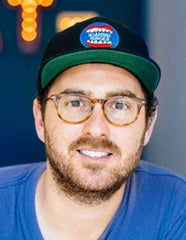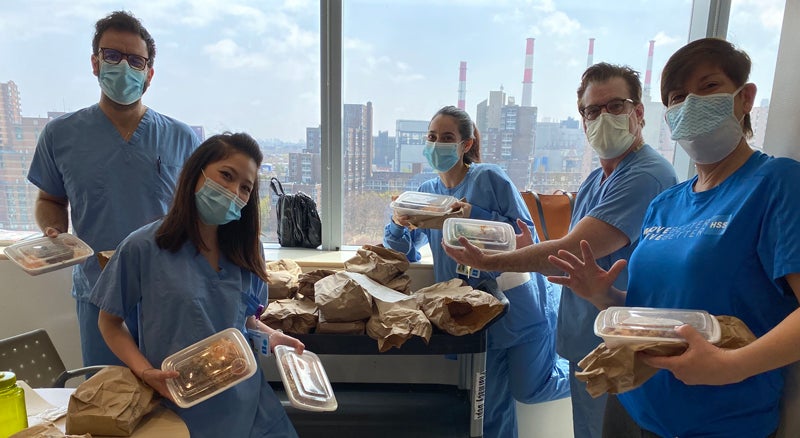Road Warriors
Road Warriors

Mircea Vlaicu (’15) is growth marketing director of mobile food platform Roaming Hunger | In support of the Black Lives Matter movement and other social change efforts, Roaming Hunger launched the Conversation Truck to create a safe community space for uncomfortable conversations
Originally, food trucks were known mostly for parking near construction sites, offering burger and burrito lunches to hungry workers. But in December 2008, L.A. food entrepreneur Roy Choi brought a truck serving Korean fusion tacos to the UCLA dorms to feed hungry Bruins studying for finals. With the newly popular Twitter to spread the word, Choi built the Kogi food truck empire and started a movement that is now ubiquitous.
Roaming Hunger was founded in 2009 by Ross Resnick (’14), originally as a platform on which to help adventurous eaters find gourmet food trucks. Based in Los Angeles, the company now does business with more than 18,000 mobile food partners across the U.S. and Canada. They added RMNG, an experiential marketing arm that works with brands to create live mobile events.
Mircea Vlaicu (’15) joined Roaming Hunger in 2016 as the growth marketing director, leading his team to focus on positioning the company as a leader in the mobile food industry. Vlaicu spoke to us about how Roaming Hunger has pivoted during the COVID-19 pandemic by coordinating food delivery to nonprofits, supporting mobile food entrepreneurs to stay in business and joining the conversation when the Black Lives Matter peaceful protests began
I joined to run the marketing team four years ago. I inquired about my position on the 4th of July, 2016, a year after I graduated. Ross Resnick responded the same day.

Roaming Hunger founder Ross Resnick (’14)
The reason I got an MBA is I needed to jumpstart my career. I needed a different direction. I started the Fully Employed MBA and began networking. I got involved in clubs such as the Entrepreneurs Association and Marketing Association. I needed help with everything, from interviewing to getting my resume right. I was able to get a marketing position at a great startup called Docstoc, who I got connected with through Anderson.
Other students helped me position myself effectively so I could market myself. The Parker Career Center connected me with brand strategist Sasha Strauss (’03) as a mentor. He was super patient. He said, “Tell me what you do, and then tell me what you actually do.” He taught me how to talk about myself.
This is always a great question because the answer changes every time I answer it. Since 2009, Roaming Hunger has added over 18,000 food trucks, carts and small food businesses to our site all over the U.S. and Canada, and a few other places around the world.
Over the years we developed into the leader of the food truck industry. Event catering and concessions are a large part of our business. We bring food to birthday parties, corporate events, festivals and community events.
As our brand grew, we had inquiries about starting a food truck, so we launched our marketplace. We help food truck owners sell their vehicles and connect entrepreneurs to reputable food truck builders.
On top of that, we have an experiential marketing agency that sets up activations, mostly tours and pop-ups. So, we have expertise in bringing an experience to wherever people meet.
And that all was going really well until March. Then people gathering, which was the heartbeat of what we were doing, kind of stopped. We had to figure out what to do.
We were one of the first industries to get affected. The first week, we didn’t really know what to do. It was scary. The first thing we did was try to regroup and figure out how to take action. As cities and states began to shut down, we thought about what resources we had to help our communities, both our food partners and the public.
One of the immediate things we did was set up charitable projects to help our partners stay in business, because a lot of them were going through the same thing we were. A lot of their events and the things that they were doing, like going to an office lot, were put on hold.
The idea came from the Dream Center, a community support nonprofit in Los Angeles, which was giving out meals to their community. It started with a GoFundMe campaign that said that, for every $600 raised, we’re going to send a food truck to a local charity that’s feeding the community, or maybe a health care facility to feed nurses, for example.
We realized that we had the power to do something unique: keep our partners in business while doing good for the community and helping frontline workers and organizations. We knew our strategy was working when we got some press coverage in LA Weekly. With that initial success, we launched GoFundMe campaigns in other cities, but found success by focusing on a couple of markets. That was a big learning.
Then potential partners who saw the press coverage started reaching out. For example, Lipton Legal Group, which is based in Beverly Hills, said, “We’re raising money to feed frontline workers but we don’t have the food part figured out.”
We did all the fulfillment and all the money got passed to the food trucks. We’ve kept a bunch of small businesses busy, there are a lot of people being fed, and we’ve gotten a lot of goodwill and a little bit of press out of it. We have a whole blog that details how many meals we provided.

Roaming Hunger teams up with funding partners like cause agency WCPG to get food to frontline workers, including those at New York City’s Montefiore Hospital
For the last few months, a lot of exciting things have been happening. We’ve been very creative, focusing on food mobility in the long term and bringing food service to where it’s needed in the short term.
For example, we’re bringing 26 food trucks to a major auto maker on a daily basis to feed their workforce. Every company that’s thinking about bringing employees back to the office is going to probably do so on a limited basis, anywhere from 10% to 50%, which means their cafeterias are probably not going to be open. A mobile food solution can be a great option for them.
On the marketplace side, we’re looking to help established restaurants and brands go mobile with food trucks. The whole restaurant industry is in transition, and the innovative companies are simplifying their menus and optimizing for order-ahead, pick-up and delivery. The restaurants that have built a food truck have been pretty successful because they can drive into a neighborhood and make a lot of sales with a piece of equipment that costs much less than a brick-and-mortar.
But probably the most exciting thing we’ve done since March is what we did when the Black Lives Matter movement organized protests. Once again, we were presented with a situation that created a lot of uncertainty. Our experiential team came up with the Conversation Truck and put it on the street in 72 hours.
We’ve been at several events and protests, and the goal is to create a safe space for uncomfortable conversations in our communities. So far, it’s incredible what we’ve been able to do. It’s sort of magical. We’ve gotten community leaders involved, celebrities, and there have been a lot of positive comments. One person said having us there at one of the protests made it “the best day” of their life.
Right now we’re focusing on BLM but we’ve also participated in Pride and we’re looking to expand nationally around social causes.
To me, the Conversation Truck is another example of using our creativity and resources to make a positive impact in a way that’s unique to us. I’m really proud of it, even though I didn’t have anything to do with the project. It’s this type of thinking that’s going to lead to long-term success.
I was talking to Ross about this last week and he brought up our core values as a company: take action, join the conversation and focus but be flexible. And if we’ve done anything the last few months, it’s those three things.
We’re taking action to learn in the short term what our opportunities are. The worst thing right now is to wait for the economy to come back. If we learn now, it’s going to lead to long-term benefits. We’re focusing on what’s working now but staying flexible. And we’re communicating more than ever to make sure we’re supporting each other.
It feels like we’re in the middle of a case study that hasn’t played out yet. After a couple of years I can probably come back to Anderson and present what happened.